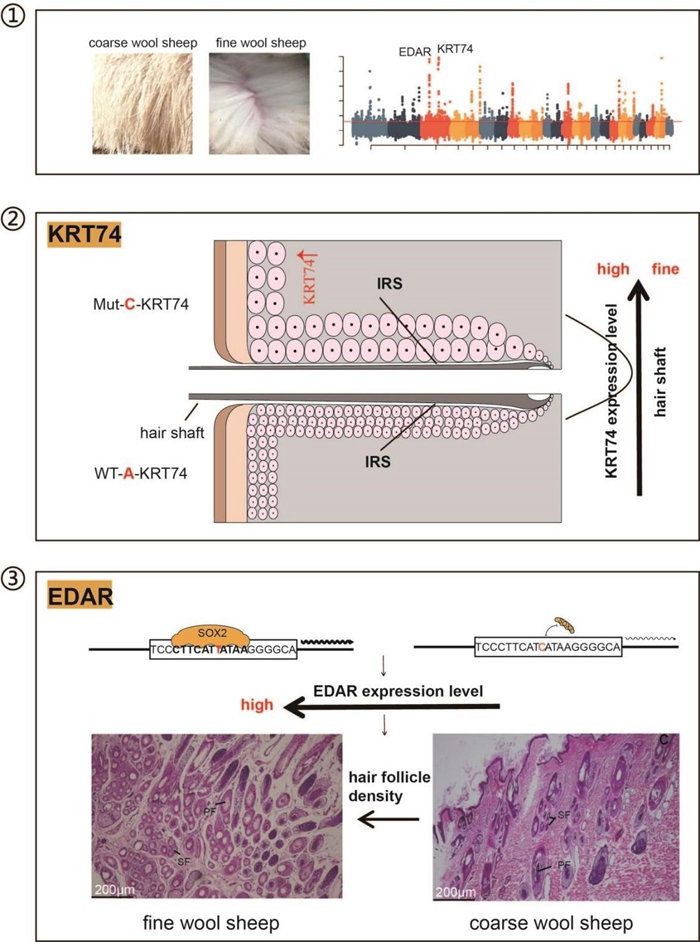Scientists from Institute of Animal Science of CAAS found that two mutations in KRT74 and EDAR regulate wool fineness and density in Chinese sheep
China is a major wool producing and consuming country, accounting for more than 20% of the world's total wool production, but it still needs to import a large amount of sheep wool per year to meet the industry need, for example, ~0.24 million tons imported in 2022. Wool fineness and density are strongly related to yield and quality. Therefore, it is critical to discover the functional genes influencing wool fineness and density in order to increase wool yield in sheep breeding.
Recently, researchers from the Science and Technology Innovation Team of Livestock and Poultry Germplasm Conservation and Utilization, Institute of Animal Sciences, Chinese Academy of Agricultural Sciences (IAS, CAAS), have identified two functional gene mutations that regulate wool fineness and density, resulting in a 1.6-2.2 kg increase in wool yield, providing a molecular breeding target for wool yield and quality improvement. This paper has been published in Journal of Advanced Research.
According to Professor Lin Jiang, the corresponding author of this paper, this study was based on the National Domestic Animal Germplasm Platform, and more than 800 Chinese and foreign sheep samples collected over the past ten years were used for the study. By integrating whole-genome re-sequencing, SNP chip and transcriptome data analysis, two causal genes were identified (Figure ①), the keratin gene Keratin 74 (KRT74) and the ectodysplasin-A receptor gene Ectodysplasin-A receptor (EDAR), to determine the fineness and density of wool, respectively. The former is a missense mutation (H123N) in KRT74, which can activate the KRT74 protein and lead to at least a two-fold enlargement of cell size at the Huxley’s layer of the inner root sheath. This structure enhancement shapes the growing hair shaft into the finer wool (Figure ②). The latter is the C-to-T mutation located in the upstream regulatory region of EDAR. This C-to-T mutation upregulated EDAR mRNA expression via a newly created SOX2 binding site and potentially led to the formation of more hair placodes (Figure ③).
Professor Lin Jiang (CAAS) is the lead corresponding author of this paper. Professor Yuehui (CAAS) and Jianfeng Liu (CAU) are the co-corresponding authors. Benmeng Liang, Tianyou Bai and Yuhetian Zhao (CAAS) were the first authors of this paper. This project was supported by the National Natural Science Foundation of China (Nos. 32222079, 31961143021); the earmarked fund for the Modern Agro-industry Technology Research System (CARS-39-01); the Science and Technology Innovation Project of the Chinese Academy of Agricultural Sciences (ASTIP-IAS01).
By Jiang Lin (jianglin@caas.cn)

Figure ①. Comparison of coarse and fine wool and identification of functional genes. Figure ②. Genetic mechanism of KRT74 gene mutation. Figure ③. Genetic mechanism of EDAR gene mutation。
More details are available at the link below:
https://doi.org/10.1016/j.jare.2023.04.012
-
 Apr 18, 2024Opening Ceremony of the Training Workshop on Wheat Head Scab Resistance Breeding and Pest Control in Africa Held in CAAS
Apr 18, 2024Opening Ceremony of the Training Workshop on Wheat Head Scab Resistance Breeding and Pest Control in Africa Held in CAAS -
 Apr 03, 2024IPPCAAS Co-organized the Training Workshop on Management and Application of Biopesticides in Nepal
Apr 03, 2024IPPCAAS Co-organized the Training Workshop on Management and Application of Biopesticides in Nepal -
 Mar 28, 2024Delegation from the School of Agriculture and Food Science of University College Dublin, Ireland Visit to IAS, CAAS
Mar 28, 2024Delegation from the School of Agriculture and Food Science of University College Dublin, Ireland Visit to IAS, CAAS -
 Mar 25, 2024Director of World Food Prize Foundation visited GSCAAS
Mar 25, 2024Director of World Food Prize Foundation visited GSCAAS -
 Mar 20, 2024Institute of Crop Sciences (ICS) and Syngenta Group Global Seeds Advance Collaborative Research in the Seed Industry
Mar 20, 2024Institute of Crop Sciences (ICS) and Syngenta Group Global Seeds Advance Collaborative Research in the Seed Industry
